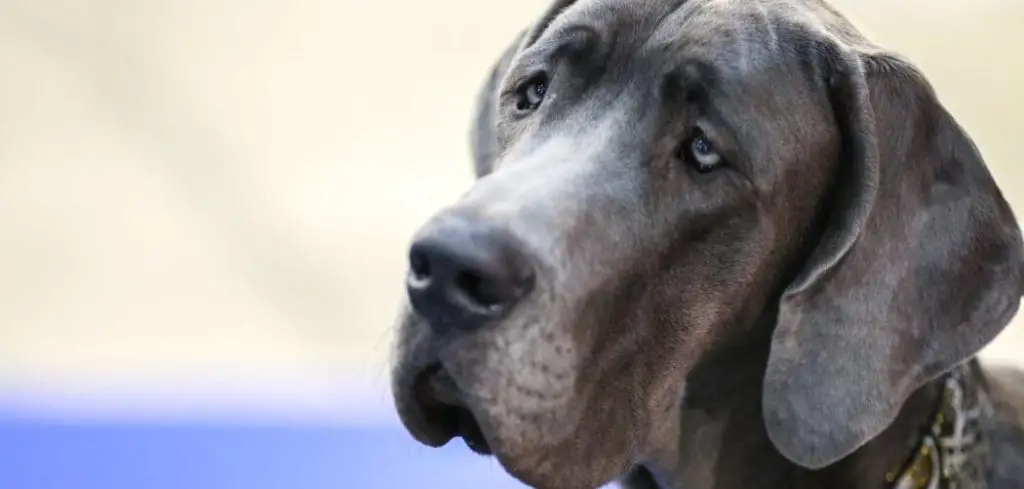A dog that is panting and has a dry nose can be alarming for dog owners, especially if these symptoms appear suddenly or persist.
While panting is a normal cooling mechanism and a dry nose can sometimes be harmless, together they may signal an underlying health problem that needs attention.
We outline the common causes of a dog panting and having a dry nose, what you can do at home, and when to seek veterinary help.
Table of Contents
Dog Panting and Dry Nose — Why It Happens
Dogs may pant and develop a dry nose due to dehydration, overheating, fever, respiratory problems, anxiety, or underlying illnesses that affect hydration and breathing.
In some cases, it could be a temporary reaction to weather or stress, but it can also indicate more urgent health concerns like heatstroke or infection. Recognizing the context and accompanying signs is key.

Dog Panting and Dry Nose: Common Causes
Heatstroke
Heatstroke is one of the most serious reasons for panting and a dry nose in dogs. When a dog’s body temperature rises dangerously high, panting increases in an attempt to cool down. The nose often becomes dry due to dehydration and overheating.
You may notice drooling, red gums, lethargy, vomiting, or collapse in addition to panting and a dry nose.
Heatstroke is a life-threatening emergency and can progress rapidly without immediate cooling and veterinary care.
Read more: Dog Panting and Not Eating (Here’s why)
Dehydration
If a dog is not drinking enough water or has been losing fluids due to diarrhea, vomiting, or excessive panting, dehydration can set in. This often causes the nose to lose its normal moisture and become dry or cracked.
Panting may become more pronounced as the body struggles to regulate temperature. Dehydration is particularly dangerous for puppies, senior dogs, and those with underlying health problems.
Fever or Infection
When a dog’s body is fighting an infection, fever can develop. Elevated body temperature can lead to both increased panting and a dry nose.
The infection could be respiratory, urinary, or systemic, and may also cause lethargy, loss of appetite, and shivering. Any unexplained fever in a dog should be taken seriously and evaluated by a veterinarian.
Respiratory Distress
Breathing problems—such as pneumonia, collapsing trachea, or heart disease—can cause panting as the dog struggles to get enough oxygen. A dry nose may result from mouth breathing and dehydration.
These conditions often present with coughing, blue-tinged gums, or reluctance to exercise. Because respiratory distress can quickly worsen, it requires prompt veterinary attention.
Anxiety or Stress
Emotional stress can trigger panting in dogs even in a cool environment. Dogs experiencing anxiety—whether due to separation, loud noises, or unfamiliar surroundings—may also stop drinking water temporarily, leading to a dry nose.
While stress-related panting may resolve once the dog feels safe, frequent or intense episodes may require behavioral support or medical evaluation.
Chronic Illness
Diseases such as Cushing’s disease, diabetes, or kidney problems can produce symptoms like panting and changes in nose moisture. Hormonal imbalances may affect body temperature regulation, while kidney issues can lead to chronic dehydration.
These illnesses usually develop gradually but require veterinary diagnosis and long-term management.
What to Do If Your Dog Is Panting and Has a Dry Nose
First, assess your dog’s environment and comfort. If they are in a warm space, move them to a cooler area and ensure they have access to fresh water. Offering small amounts of water frequently can help prevent dehydration.
Observe their breathing. If panting is heavy, labored, or accompanied by other concerning symptoms like lethargy or collapse, this is not a wait-and-see situation.
Keep your dog calm. Stress and excitement can worsen panting, so create a quiet, familiar space for them to rest.
Avoid giving human medications unless specifically directed by a vet. Instead, focus on keeping your dog comfortable and hydrated while you monitor them closely.
If your dog’s condition doesn’t improve quickly, contact your veterinarian for further guidance.
When to Call or Visit Your Vet
Seek immediate veterinary attention if your dog’s panting is excessive, they appear weak or confused, or they collapse.
Other red flags include a persistent dry or cracked nose, refusal to drink water, pale or blue gums, coughing, or signs of pain.
Heatstroke, severe dehydration, and respiratory distress can become fatal in hours, so err on the side of caution and get your dog checked promptly.
Read more: Dog panting excessively (Should you worry?)
Key Takeaway
Panting and a dry nose in dogs can be caused by something as mild as a warm day or as serious as heatstroke or illness. By observing other symptoms and acting quickly when necessary, you can help protect your dog’s health.
When in doubt, contact your veterinarian. It’s always better to have a professional evaluation than to risk a preventable emergency.
